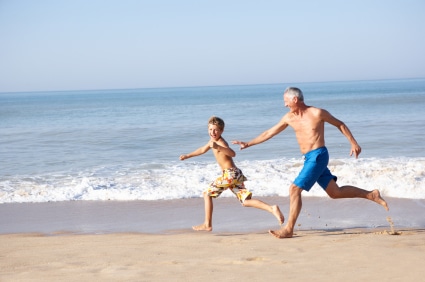 Aerobic capacity refers to your body’s maximal ability to do exercise. It’s a measure of how well your heart functions and how efficiently your blood extracts oxygen from the lungs to transport to cells that need it. Aerobic capacity is measured in the laboratory by having a person do progressively more intense exercise while measuring oxygen consumption. The point at which oxygen use plateaus is a measure of aerobic capacity or aerobic fitness and is expressed as VO2 max.
Aerobic capacity refers to your body’s maximal ability to do exercise. It’s a measure of how well your heart functions and how efficiently your blood extracts oxygen from the lungs to transport to cells that need it. Aerobic capacity is measured in the laboratory by having a person do progressively more intense exercise while measuring oxygen consumption. The point at which oxygen use plateaus is a measure of aerobic capacity or aerobic fitness and is expressed as VO2 max.
As you might expect, VO2 max goes down with age. In fact, it declines by more than 1% each year of life in both men and women starting during early adulthood. The good news is people who exercise reduce this rate of decline by almost half. On the other hand, people who are sedentary or who become significantly overweight or obese can see a faster reduction in their VO2 max. Another good reason to stay active, huh?
Unfortunately, even if you do a kick-butt workout every day, you can’t completely stop the gradual decline in aerobic capacity and VO2 max that comes with age. This decline starts at around the age of 25 and steadily continues over a lifetime. But one thing is certain, if you challenge your lungs and cardiovascular system with training, you’ll have a greater aerobic capacity at age 60 than couch potatoes that spend their time lounging in an easy chair. There’s a lot of truth to the statement “use it or lose it”. Your aerobic capacity is partially determined by age, sex and genetics, which you have little control over – but other factors such as your training and the amount of lean body mass you have – factors you can control – play a role too.
How much can you improve aerobic capacity and VO2 max with training? In younger people, training can increase it by 25%, and, in rare cases, up to 50%. According to a study published in the Journal of Applied Physiology, even people in their sixties can boost their aerobic capacity by as much as 22% through training.
You’re never too old to get the health benefits of exercise. In fact, according to a case discussed in the fifth edition of Exercise Physiology by McArdle, Katch, and Katch, an 86 year old man was able to run a marathon at a record 12.9-minute mile pace for his age group. Even if you’re not this fast in your eighties, you can still keep chugging along.
Hanging onto aerobic fitness should be motivation to keep on training – and for beginners, it’s never too late to start. No matter what your age, you can still improve aerobic fitness by doing exercise that challenges your cardiovascular system. You’ll not only reduce the amount of weight you gain with age but lower your risk of heart disease as well.
According to a study published in the journal Circulation, people with higher aerobic capacity reduce their risk of arterial stiffness, a condition that can lead to a heart attack. So, keep on exercising as you age, but give yourself more time to recover between workouts to reduce your risk of overuse injuries. Be kind to your muscles, tendons, and joints.
References:
J.Appl. Physiol. 1993; 75:849.
Circulation. 1993 Oct;88(4 Pt 1):1456-62.
Related Articles By Cathe:
What Type of Exercise is Best for Improving Aerobic Capacity? Hint: It’s Not Jogging
High-Intensity Interval Training: How Intense Does It Have to Be?
Is Being Aerobically Fit Key to Longevity?
How Accurate Is Maximum Heart Rate for Measuring Exercise Intensity?
What Role Does Aerobic Capacity Play in Successful Aging?
Why Does Aerobic Capacity Go Down as You Age?
How Much Can You Improve Your Aerobic Capacity?
Aerobic Fitness Test: How to Measure Your Aerobic Capacity

